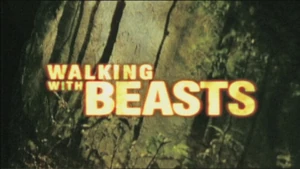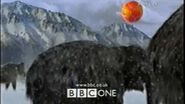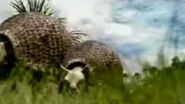| ||||||||||||||||||||||
| [Source] | ||||||||||||||||||||||
Walking with Beasts - broadcast in North America as Walking with Prehistoric Beasts - is a six-part television documentary produced by the BBC in the United Kingdom, narrated by Kenneth Branagh, and released in 2001. In North America the original Discovery Channel broadcast was narrated by Stockard Channing. Like its predecessor, Walking with Dinosaurs, it recreates life in the Cenozoic by using a combination of both computer-generated imagery and animatronics. However, the Miocene epoch and Palaeocene epoch are not included.
Also like its predecessor, it was re-edited and re-narrated as a second "season" of Prehistoric Planet for the Discovery Kids lineup. Some of the concepts it illustrates are the evolution of whales, the evolution of the horse, and the evolution of humans.
Episodes
| Image | Episode title | Episode number | Original airdate | |
|---|---|---|---|---|

|
New Dawn | 1 | 15 November 2001 | |
| The first episode focuses on the warm and tropical world of the early Eocene, 16 million years after the extinction of the non-avian dinosaurs. During this time, the mammals still have remained small, for there is little space for them to get back in the crampled conditions of the jungle, and birds - who were already large in the Mesozoic - dominate the world as shown by Gastornis, the first of such flightless giants. | ||||

|
Whale Killer | 2 | 22 November 2001 | |
| The second episode is set in late Eocene, when the polar caps froze over and drastically change the Earth's ocean currents and climate. The episode follows an early whale, Basilosaurus and how the world is changing into an ocean famine. We also follow on land an Andrewsarchus, the largest land mammal predator ever to walk the earth, and the prehistoric rhino Embolotherium. | ||||

|
Land of Giants | 3 | 29 November 2001 | |
| The third episode takes place during the late Oligocene, in Mongolia, where there were seasonal rains followed by a long drought. It tells the story of a mother Indricotherium, a massive hornless cousin of the modern rhinoceroses that was the largest land mammal to have ever lived. It also features the Entelodon, and the Hyaenodon. | ||||

|
Next of Kin | 4 | 6 December 2001 | |
| The fourth episode takes place in the Great Rift Valley in northeastern Africa. The episode focuses around a tribe of small hominids known as Australopithecus, one of the first apes able to walk upright and a close ancestor to humans. Some of the topics explored in the episode are the close social bonds among the tribe, how they use grooming as a means of communication, and how they work together to forage for food and to defend one another from attacks from such animals as an angry male Deinotherium, an ancestor of the modern elephant which they have to run from to avoid being crushed, and the feline predator Dinofelis. | ||||

|
Sabre Tooth | 5 | 13 December 2001 | |
| The fifth episode shows the strange fauna of the isolated continent of South America and explores the effects of the Great American Interchange, which had happened 1.5 million years earlier. The episode focuses on a male Smilodon, a sabre-toothed cat, called Half Tooth, whose leadership of a pride is threatened by two males who are brothers and work together against him. The rival males ultimately chase off Half Tooth (actually Half Tooth backs off wisely without any serious injuries, feeling that the two males would be too strong for him), kill his cubs, and take over his pride. | ||||

|
Mammoth Journey | 6 | 21 December 2001 | |
| The sixth episode takes place during the last Ice Age. It starts in the peak of the summer. The North Sea has become a grassy plain because the ice at the polar caps has caused the sea levels to drop significantly. Grazing on the plain are herds of Woolly mammoths, wild horses, and bison. A clan of Cro-Magnons are also there spending the summer. The central focus of the episode is the migration of the herd of mammoth as they travel 400 kilometers from the North Sea to the Swiss Alps for the winter and then back again in the spring. | ||||
Gallery
Videos
Companion book
A companion book was written by Tim Haines to accompany the first screening of the series in 2001. Unlike Walking with Dinosaurs, this book is more accurate in describing each episode, and there are no interesting setting changes. On the other hand, as with Walking with Dinosaurs, the written version of Walking with Beasts elaborated on the background for each story, went further in explaining the science on which much of the program as based, and included descriptions of several animals not identified or featured in the series.
Related Media
Andy's Prehistoric Adventures
Andy's Prehistoric Adventures is an educational television series targeted towards young children which aired on CBeebies. The series often uses scenes from Walking with Beasts to depict the creatures mentioned in the programme.



